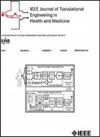Detection of Chronic Musculoskeletal Pain Using Voice Characteristics
IF 4.4
3区 医学
Q2 ENGINEERING, BIOMEDICAL
IEEE Journal of Translational Engineering in Health and Medicine-Jtehm
Pub Date : 2025-03-24
DOI:10.1109/JTEHM.2025.3553892
引用次数: 0
Abstract
Physical pain, particularly musculoskeletal pain, negatively impacts the activities of daily life and quality of life of elderly people. Because pain is a subjective sensation and there are no standard assessment procedures to detect pain, we attempted to quantitatively determine the actual state of chronic pain caused by musculoskeletal organs and related factors based on questionnaires. First, we studied techniques for diagnosing diseases by monitoring the involuntary characteristics of the voice. Then, we applied the technique based on voice characteristics and proposed a voice index to detect chronic musculoskeletal pain. The voice index was derived based on the assumption that physiological changes due to chronic musculoskeletal pain also affect the vocal cords. Subjects in this study were adults, 65 years of age or older, with chronic pain in the musculoskeletal system (lumbar and/or knees). A large-scale population-based cohort study was conducted in 2019. Voice characteristics were extracted from the recorded voices of the subjects, and the characteristics with similar properties were organized into several principal components using principal component analysis. The principal components were further combined using logistic regression analysis to propose a voice index that discriminates between normal subjects and subjects suffering from chronic musculoskeletal pain. A discrimination accuracy of approximately 80% was obtained using the dataset corresponding to the participants with knee pain only, and a discrimination accuracy of approximately 70% was obtained during cross-validation of the same dataset. The proposed voice index may serve as a novel tool for detecting chronic musculoskeletal pain. Clinical impact: The voice-based pain detection holds clinical significance owing to its noninvasive nature, ease of administration, and potential to efficiently assess large populations within a short time frame.利用声音特征检测慢性肌肉骨骼疼痛
身体疼痛,特别是肌肉骨骼疼痛,对老年人的日常生活活动和生活质量产生负面影响。由于疼痛是一种主观感觉,没有标准的评估程序来检测疼痛,我们试图通过问卷调查来定量确定肌肉骨骼器官及相关因素引起的慢性疼痛的实际状态。首先,我们研究了通过监测声音的非自愿特征来诊断疾病的技术。然后,我们将该技术应用于基于声音特征的方法,并提出了一个声音指数来检测慢性肌肉骨骼疼痛。声音指数是基于慢性肌肉骨骼疼痛引起的生理变化也影响声带的假设而得出的。本研究的受试者是65岁或以上的成年人,患有肌肉骨骼系统(腰椎和/或膝盖)的慢性疼痛。2019年进行了一项大规模人群队列研究。从被试录制的声音中提取声音特征,利用主成分分析将具有相似属性的特征组织成多个主成分。使用逻辑回归分析将主成分进一步组合,提出区分正常受试者和患有慢性肌肉骨骼疼痛的受试者的声音指数。使用仅与膝关节疼痛参与者对应的数据集获得了约80%的识别准确率,并且在同一数据集的交叉验证中获得了约70%的识别准确率。提出的声音指数可以作为一种检测慢性肌肉骨骼疼痛的新工具。临床影响:基于语音的疼痛检测具有临床意义,因为它的非侵入性,易于管理,以及在短时间内有效评估大量人群的潜力。
本文章由计算机程序翻译,如有差异,请以英文原文为准。
求助全文
约1分钟内获得全文
求助全文
来源期刊

IEEE Journal of Translational Engineering in Health and Medicine-Jtehm
Engineering-Biomedical Engineering
CiteScore
7.40
自引率
2.90%
发文量
65
审稿时长
27 weeks
期刊介绍:
The IEEE Journal of Translational Engineering in Health and Medicine is an open access product that bridges the engineering and clinical worlds, focusing on detailed descriptions of advanced technical solutions to a clinical need along with clinical results and healthcare relevance. The journal provides a platform for state-of-the-art technology directions in the interdisciplinary field of biomedical engineering, embracing engineering, life sciences and medicine. A unique aspect of the journal is its ability to foster a collaboration between physicians and engineers for presenting broad and compelling real world technological and engineering solutions that can be implemented in the interest of improving quality of patient care and treatment outcomes, thereby reducing costs and improving efficiency. The journal provides an active forum for clinical research and relevant state-of the-art technology for members of all the IEEE societies that have an interest in biomedical engineering as well as reaching out directly to physicians and the medical community through the American Medical Association (AMA) and other clinical societies. The scope of the journal includes, but is not limited, to topics on: Medical devices, healthcare delivery systems, global healthcare initiatives, and ICT based services; Technological relevance to healthcare cost reduction; Technology affecting healthcare management, decision-making, and policy; Advanced technical work that is applied to solving specific clinical needs.
 求助内容:
求助内容: 应助结果提醒方式:
应助结果提醒方式:


